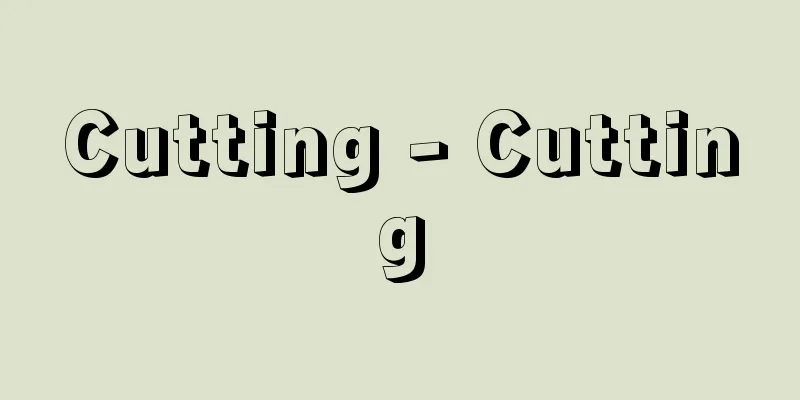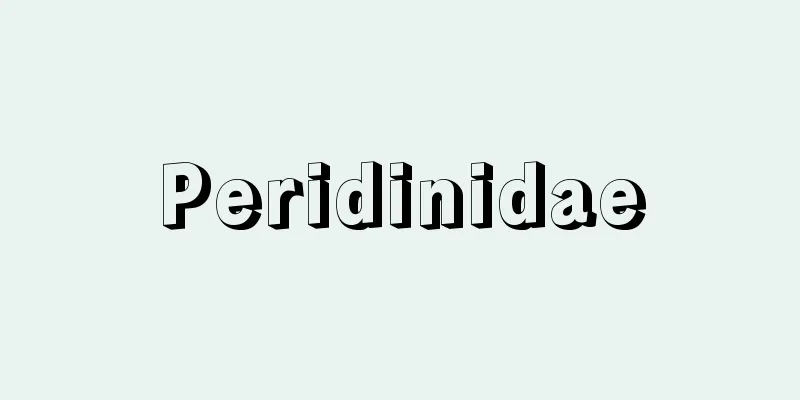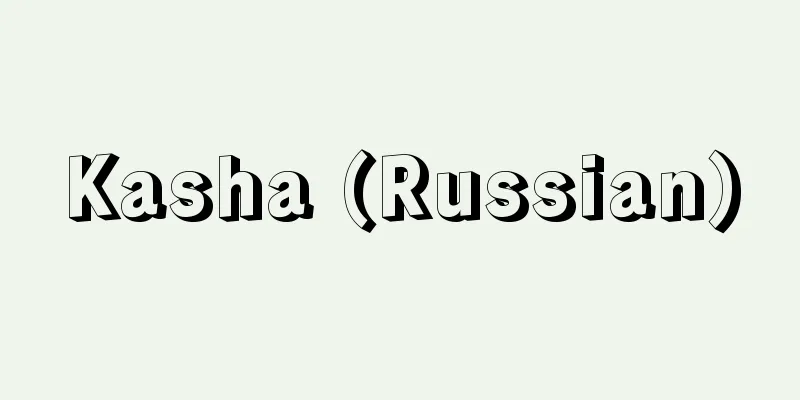Cutting - Cutting

|
It is a method used to propagate plants, in which stems (branches), leaves, and roots of flowering trees and plants are cut off and inserted into soil or sand to regenerate new individuals. In the case of herbaceous plants such as chrysanthemums, carnations, and dahlias, this is often called grafting. The part that is inserted is called a scion. Grafting is a widely used propagation method because it is asexual (vegetative) propagation, and has the following features: it is possible to obtain many seedlings with the same qualities (genetic quality) as the parent (mother tree), it flowers and bears fruit earlier than seedlings, and the propagation process is easy. However, not all plants can be propagated by grafting, and some are easier to root than others, depending on the plant's regenerative ability. Other asexual propagation methods include layering, division, and grafting. It is difficult to know exactly when grafting was first practiced, but it is said that it was practiced in Greece around 3000 BC. In Japan, the gardening book "Kadan Komoku" published in 1681 (Tenwa 1) states that "it is auspicious to take grafts," so it is believed that the technique of grafting was already in use at that time. There are also many stories of grafts made by Kukai, who traveled around Japan using walking sticks and branches, which can also be considered a type of grafting. [Yasuo Hori] Types of cuttingsDepending on the part of the plant used as the cutting, it can be divided as follows: [1] Stem cuttings (branch cuttings): This is the most common. Usually, cuttings of about 10 cm in length with 2-4 buds are made. Cuttings made from the tip of the stem are called zen-sashi, choga-sashi, or ko-sashi. The part below is called kuda-sashi. Cuttings must have axillary buds, and those missing are not suitable for use as cuttings. Cuttings made from growing branches are called ryokushi-sashi, and cuttings from branches that have lost their leaves are called dormant-sashi. With evergreen trees, cuttings with one leaf and one bud attached are called hitome-sashi. This method is used to propagate ornamental plants, as many cuttings can be made at once. [2] Leaf cuttings There are whole leaf cuttings, where a single leaf is inserted as is (Selaginella japonica, Streptocarpus, etc.), cuttings with the petiole attached, and cuttings of leaves cut into several pieces (cut cuttings, Begonia, Sansevieria, etc.). A similar method is the bulb scale propagation method, where a bulb is split lengthwise into several pieces and inserted into a cutting bed to allow the bulblets to grow. This is used for amaryllis, hyacinths, etc. [3] Root cuttings: Cuttings are made by cutting a part of the root and allowing it to sprout. This method is also called root laying. This method is used for plants that do not require much maintenance or large quantities. It is often used for root laying propagation of Erythrina, Paulownia, and Robinia pseudoacacia, as well as Japanese primrose. There are also several ways to insert cuttings: (1) vertical insertion, where the cutting is inserted vertically, (2) oblique insertion, where the cutting is inserted at a slight angle, (3) horizontal insertion, where the cutting is inserted horizontally into the ground, and (4) other methods, such as the boat-bottom insertion method for climbing plants and the dumpling insertion method for flowers, where the cut end is wrapped in a clay dumpling. [Yasuo Hori] Factors affecting root growth and root growth promotion treatmentRooting from cuttings is influenced by external factors such as temperature, humidity, and sunlight, as well as by the condition of the cutting. Cuttings with a lot of stored nutrients (carbohydrates) are more likely to promote rooting. For example, when taking cuttings of evergreen trees such as camellias, there will be a difference in the time it takes for rooting to begin between upper branches that get a lot of sunlight and lower branches that get less sunlight. Branches and leaves that are still growing do not have enough accumulated nutrients and will wilt quickly, while over-ripened cuttings will senesce and rooting will be delayed. Cuttings usually do not root well at temperatures below 10°C, and are prone to rotting at soil temperatures above 30°C. Exposure to light promotes rooting. However, if the plant has leaves, high leaf surface temperatures can cause excessive evaporation from the leaves, which can lead to the plant's death. The quality of the soil plays a major role in promoting rooting of cuttings. Soil must have excellent water retention and breathability, and must not be contaminated by decay-causing bacteria. A soil acidity of pH 5.5 to 6 is also preferable. Natural soils include river sand, akadama soil, Kanuma soil, peat moss, and sphagnum moss, while artificial soils include perlite, vermiculite, urethane, and kuntan. [Yasuo Hori] Rooting promotion treatmentFor plants that are difficult to root or have few roots, there are various methods for treating the mother plant or cuttings to encourage rooting. [1] Treatment of the parent tree (1) Etiolation treatment This is applied to species of deciduous trees that are difficult to root. When new shoots begin to sprout, the whole plant is placed in a greenhouse with weak light or a branch is covered with a translucent material to make the stem young, which is then used as a cutting. (2) Nutrient accumulation treatment The bark of part of a thick branch is ring-barked or scratched, and the carbohydrate content in the stem and leaf to be used as the cutting is increased, allowing nutrients to accumulate and making it easier to root. This has the disadvantage of being a time-consuming process, but is effective. [2] Treatment of cuttings (1) Water absorption treatment: Allow cuttings to absorb water sufficiently (about 1 to 10 hours), wash away the sap from the cut end, improve water absorption of the conductive tissue, and inhibit the action of oxidizing enzymes to promote root growth. (2) Drying treatment: For succulents with a lot of moisture or flowers that rot easily, dry them in the shade once and insert them after the cut end has closed (geraniums, cacti, etc.). (3) Chemical treatment: Hormones and oxidation inhibitors are used to promote root growth. The main chemicals used are IAA, IBA, NAA, and NAd, but their effectiveness varies depending on the tree species, and there are pros and cons depending on the concentration. [Yasuo Hori] InsertionFor plants with strong rooting power, simply dig up the soil in the garden and soften it before cutting. However, for plants with weak rooting power, some ingenuity is required for cutting, and various cutting methods are used from the perspective of horticultural production. [1] Box vase (pot vase) Made using wooden boxes or plastic (styrofoam boxes), this is convenient for storing a small number of plants and for transporting them. [2] Bed planting This is a method often used by professional growers. There are two ways to plant the bed: by piling up the soil in a rectangular shape, or by creating an outer frame and placing the soil inside. This is a bed planting with good drainage. This method tends to dry out the plants easily in the summer, so it is necessary to shade them with cheesecloth or reed screen. [3] Sealed cuttings After taking the cuttings, completely seal the bed or pot with polyethylene film (or vinyl) and allow them to root. This method is a labor-saving propagation method because it only requires sufficient watering when taking the cuttings and no watering until the roots take shape. The temperature inside can get high and cause the leaves to burn, so sufficient shading is required. When removing the covering, it is important to first make holes in the film and gradually allow the cuttings to get used to the outside air; if it is removed all at once, the sudden change in environment will cause them to shrink and their growth to be stunted. [4] Mist cuttings: A cutting bed is made in a greenhouse, and the cuttings are sprayed with mist water as needed to maintain humidity, and the temperature and sunlight are adjusted to encourage rooting. This method requires equipment costs, but it allows cuttings to be taken many times and many seedlings to be obtained. [Yasuo Hori] Time for cuttingsThe time for cuttings under natural conditions can be divided into the following categories based on temperature, humidity, sunlight, and maturity of the cuttings. (1) Spring cuttings (February to March) Cuttings are mainly made from dormant branches of deciduous trees before they sprout. For evergreen trees, branches from the previous year are used, but many of these have poor rooting properties. (2) Summer cuttings (rainy season cuttings) For both evergreen and deciduous trees, cuttings are best made when the new shoots have stopped growing and become somewhat hard. This is especially the time when temperature, humidity, and sunlight are relatively stable, and cuttings are well ripe. Cuttings that grow a little slower but are more mature are also called July cuttings or Doyo cuttings. (3) Autumn cuttings (September cuttings) The branches and leaves that grew in summer are mature, and with the drop in temperature and increase in humidity, this is the time when cuttings are more likely to root. However, cuttings made during this time will be subject to frost damage in 2 to 3 months, so measures to protect them from the cold are required. [Yasuo Hori] Care and maintenance of cuttingsThe cutting bed should be watered thoroughly before taking the cuttings, and watered again after taking the cuttings to settle the bed soil. The period of about 15 days after taking the cuttings can be considered a resting period. During this time, if the cuttings move, they will not take root well, so do not take them too high and do not expose them to strong winds. In addition, in summer, leaves can easily get burned by direct sunlight, so it is necessary to provide shade and block more than 50% of the light. Rooting takes about 30 to 60 days for woody plants, but some, such as conifers, can take more than six months. Herbaceous plants take root relatively quickly, with most taking root in 20 to 40 days. The period for shading herbaceous plants is usually about two weeks. It is important not to let the bed soil dry out. Except for sealed cuttings, occasional foliar watering to lower the temperature of the leaf surface will also help to improve rooting. [Yasuo Hori] [References] | | | | |©Katsuya Nishikawa "> Cuttings - Stem Cuttings (How to take cuttings) ©Katsuya Nishikawa "> Cuttings - Stem Cuttings (How to Cut Cuttings) ©Katsuya Nishikawa "> Cuttings - Stem cuttings (how to insert cuttings) ©Katsuya Nishikawa "> Cuttings – Leaf and root cuttings ©Shogakukan "> The best time to take cuttings of major plants Source: Shogakukan Encyclopedia Nipponica About Encyclopedia Nipponica Information | Legend |
|
花木や草花などの茎(枝)や葉、根を切り取って土や砂などに挿し、新個体に再生させるもので、植物を殖やすときに用いる手法の一つである。キクやカーネーション、ダリアなどの草本植物では挿芽ということが多い。挿す部分を挿穂という。挿木は、無性繁殖(栄養繁殖)のため親(母樹)と同じ素質(遺伝質)をもった苗を多数得ることができることや、実生(みしょう)に比べて早期に開花・結実がみられること、増殖作業が簡単であるなどの特長を有するところから、広く利用されている繁殖方法である。ただ、すべての植物を挿木によって増殖できるわけではなく、植物体の再生力により、発根しやすいものと、しにくいものがある。そのほかの無性繁殖の方法には、取木、株分け、接木(つぎき)などがある。 挿木が初めて行われるようになった年代を明確に知ることはむずかしいが、紀元前3000年ごろのギリシアでは挿木が行われたともいわれる。わが国では1681年(天和1)に出版された園芸書『花壇綱目』に「取木挿木に吉」との記載がみられるところから、このころにはすでに挿木の手法が活用されていたものと思われる。また日本各地には空海が諸国を巡りながら杖(つえ)や枝を挿したものがいろいろ伝えられているが、これも挿木の一種といえよう。 [堀 保男] 挿木の種類挿穂として用いる植物の部位によって次のように分けられる。 〔1〕茎挿し(枝挿し) もっとも一般的なもの。普通、芽を2~4個つけた長さ10センチメートル前後の挿穂をつくる。茎の先端を挿穂としたものを天挿しとか頂芽(ちょうが)挿し、心挿しという。それより下の部分は管(くだ)挿しという。挿穂はかならず腋芽(わきめ)が必要で、欠けているものは挿穂としてよくない。また、生育中の枝を挿穂として挿木したものを緑枝(りょくし)挿し、落葉中の枝を挿木することを休眠挿しとよぶ。常緑樹では、一葉一芽をつけて挿木することを一芽(ひとめ)挿しという。これは一度に多数の挿穂ができるところから、観葉植物の増殖に利用されている。 〔2〕葉挿し 1枚の葉をそのまま挿す全葉挿し(イワヒバ、ストレプトカーパスなど)と、葉柄をつけて挿すもの、いくつかに切った葉片を挿すもの(裁断挿し。ベゴニア、サンセベリアなど)がある。また、似た手法に球根の鱗片(りんぺん)繁殖法がある。これは、球根を縦にいくつかに割り、挿床に挿し、子球を出させるもので、アマリリス、ヒヤシンスなどで利用されている。 〔3〕根挿し 根の一部を切り取って挿穂とし、芽を出させる方法で、根伏せともいう。この方法は、管理に手数があまりかからないものや、数量を多くは必要としないものに利用される。アメリカデイコ(エリスリナ)、キリ、ニセアカシアのほか、草花ではニホンサクラソウの根伏せ繁殖によく用いられている。 また、挿穂の挿し方には次のようなものがある。(1)垂直挿し 挿穂を垂直に挿す方法、(2)斜め挿し 挿穂をやや斜めに挿す方法、(3)水平挿し 挿穂を水平に埋めて挿す方法、(4)その他 つる性のものでは舟底挿し、草花類では粘土の団子で切り口を包む団子挿しの方法などがある。 [堀 保男] 発根の要因と発根促進処理挿木による発根は、温度、湿度、日照などの外的要因に影響されるほか、挿穂の状態にも大きく左右される。貯蔵されている養分(炭水化物)の多い挿穂が発根を促す力が大きい。たとえばツバキなどの常緑樹の挿木では、日当りのよい上枝と悪い下枝では、発根開始に差ができる。生育途中の枝葉は養分の蓄積が不十分で萎凋(いちょう)が早く、成熟しすぎたものは老化し、発根が遅れる。 挿穂は、通常10℃以下では発根作用が鈍り、地温が30℃以上では腐敗がおこりやすい。光を受けることは発根作用を促進させる。しかし、葉がある場合は、葉面の温度が高くなることで葉面蒸発が盛んになり枯死することもある。挿穂の発根を促すには用土の質が大きく関係する。用土は、保水性、通気性に優れていることと、腐敗菌に汚染されていないことが要求される。また、土壌酸度はpH5.5~6が好ましい。天然用土では、川砂、赤玉土、鹿沼土(かぬまつち)、ピートモス、ミズゴケ、人工用土ではパーライト、バーミキュライト、ウレタン、クンタンなどがある。 [堀 保男] 発根促進処理発根が困難だったり根数の少ない植物は、発根を促すために母樹や挿穂にいろいろ処理をする方法がある。 〔1〕母樹に対する処理 (1)黄化処理 落葉樹の発根しにくい種類に応用するもので、新芽が伸び始めたときに、株全体を弱光線の温室内に置いたり、一枝を半透明のもので被覆したりして、茎を若い状態にしたものを挿穂とする。(2)養分蓄積処理 太枝の一部の樹皮に環状剥皮(はくひ)を行うか傷をつけ、挿穂とする茎葉内に炭水化物の含有量を高めることにより養分の蓄積ができ、発根しやすくする。作業に手間がかかる不利はあるが、効果はある。 〔2〕挿穂に対する処理 (1)吸水処理 挿穂に十分吸水させ(1~10時間内外)、切り口の汁液を洗い、通道組織の吸水をよくし、あわせて酸化酵素の作用を抑制し、発根を促す方法。(2)乾燥処理 水分の多い多肉質のものや腐りやすい草花類では、一度日陰で乾燥させて、切り口がふさがってから挿す(ゼラニウム、サボテン類など)。(3)薬品処理 発根を高めるため、ホルモン剤の使用や酸化抑制剤が利用されている。使われる薬剤は主としてIAA、IBA、NAA、NAd剤などあるが、有効性は樹種により異なり、濃度差により長短がある。 [堀 保男] 挿床発根力の強い植物では、挿床は、庭先の土をよく掘り起こし軟らかくしただけでよい。しかし、発根力の弱いものは、挿床をくふうする必要があり、また、園芸の生産面から種々の挿床が用いられる。 〔1〕箱挿し(鉢挿し) 木箱、プラスチック(発泡スチロール箱)などを用いたもので、少数挿しと移動に便利である。 〔2〕床挿し 専業生産者がよく用いる方法で、床土を短冊状に盛り上げる方法と、外枠をつくり、中に床土を入れる方法とがある。排水をよくした挿床である。この方法は夏に乾燥しやすいので、上を寒冷紗(かんれいしゃ)やよしずなどで遮光することが必要である。 〔3〕密閉挿し 挿木したあとに床や鉢全体をポリエチレンフィルム(またはビニル)で完全密閉し、発根させる。この方法は、挿木するときに十分灌水(かんすい)し、あとは発根まで無灌水であるため、省力化した増殖法である。内部が高温となり葉焼けをおこすので、十分な遮光が必要となる。なお、被覆物を取り除くときは、まずフィルムに穴をあけ徐々に外気に慣らすことがだいじで、一度に取り去ると環境の激変により萎縮して生育が阻害される。 〔4〕ミスト挿し 温室内に挿床をつくり、挿穂に必要に応じて水を霧状に噴射させることにより湿度を保持し、さらに温度、日照を調節し発根を促す。この方法は設備費がかかるが、挿木回数を多くして、多数の苗を得ることができる。 [堀 保男] 挿木の時期自然条件下での挿木の時期は、温度、湿度、日照、穂の熟度から次のように区分できる。(1)春挿し(2~3月) 主として落葉樹の萌芽(ほうが)前の休眠枝を挿穂として利用する。常緑樹では前年枝を用いるが、発根の悪いものが多い。(2)夏挿し(梅雨(つゆ)挿し) 常緑樹、落葉樹ともに、新梢(しんしょう)が伸長を一時停止し、やや固くなったころがよい。とくにこのころは温度、湿度、日照が比較的安定し、挿穂の熟度もよい。また、成長がやや遅れて充実するものは七月挿しあるいは土用挿しともいう。(3)秋挿し(九月挿し) 夏に伸びた枝葉が充実し、温度の低下と湿度の増大で挿木しても発根しやすい時期となる。しかしこの時期に挿木したものは、2~3か月で冬となるため、凍霜害を受けやすいところから、防寒対策が必要となる。 [堀 保男] 挿木の管理と手入れ挿木は挿床に十分灌水してから行うが、挿木が終わったら再度灌水し、床土を落ち着かせる。挿木してから約15日間は安静期間ともいえる。その間、挿穂が動いたりすると発根が悪くなるので、高挿しとならないようにし、強い風に当てないようにする。また夏は直射日光で葉焼けをおこしやすいので、日よけをし、50%以上遮光する必要がある。発根は木本類で30~60日程度であるが、針葉樹のように6か月以上かかるものもある。草本類では比較的早く、20~40日で発根するものが多い。草本類では、遮光する期間は普通2週間程度である。床土は乾燥させないことがだいじである。密閉挿し以外は葉面灌水をときどき行って、葉面の温度を下げることも活着をよくすることに通じる。 [堀 保男] [参照項目] | | | | |©西川勝也"> 挿木―茎挿し(挿穂のとり方) ©西川勝也"> 挿木―茎挿し(挿穂の切り方) ©西川勝也"> 挿木―茎挿し(挿穂の挿し方) ©西川勝也"> 挿木―葉挿しと根挿し ©Shogakukan"> おもな植物の挿木の時期 出典 小学館 日本大百科全書(ニッポニカ)日本大百科全書(ニッポニカ)について 情報 | 凡例 |
Recommend
The Weaver - Oriko (English spelling) Die Weber
A five-act play by German playwright G. Hauptmann...
Shimokita side
〘Noun〙 Among the warriors of the north side who gu...
Rohrbach, J.
... In Franconia, after March 22, 163 villages ar...
Tricot (English spelling)
This refers to warp knitted knitted fabrics. The o...
Jinaimachi - Jinaimachi
An artificial town created in the first half of t...
Maonan tribe (Maonan people) - Maonan tribe (English spelling) Máo nán zú
One of China's ethnic minorities. They live in...
Shell Science - Shell Science
…With the emergence of Charles Darwin in the 19th...
Stonework - Ishitsukuri
...a craftsman who cuts stone (quarries), process...
Matsushiro Domain
This clan ruled over northern Shinano, with its h...
Huayang Yì Zhèn Huì (English: Huá yáng yì zhèn huì)
A Chinese charity organization. Its official name ...
Misato [village] - Misato
A village in Aki County in north-central Mie Prefe...
Timber yard
A timber dumping site fully equipped with storage...
《Note Value and Intensity Mode》 - Note Value and Intensity Mode
…Interest in elements other than pitch was seen e...
Nakano Sekiou
A shogunate official in the late Edo period. Comm...
Global Bearer Certificate (English)
…The first Japanese company to issue ADRs was Son...









